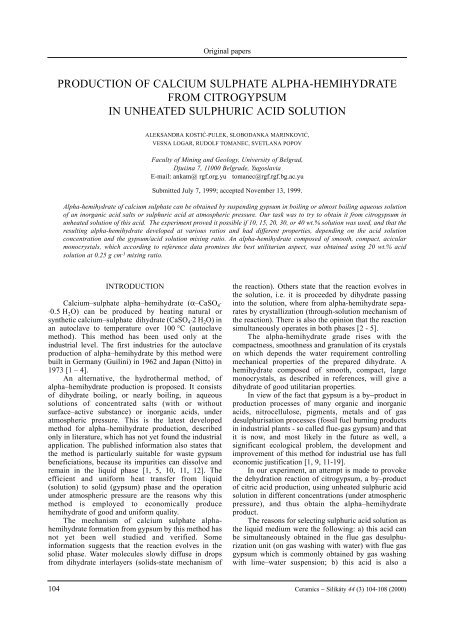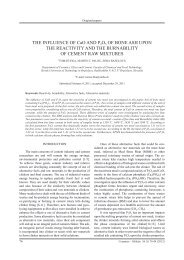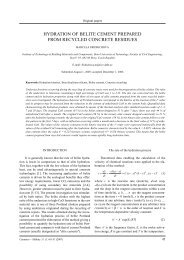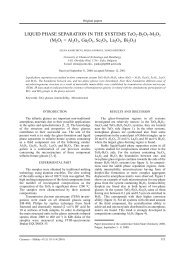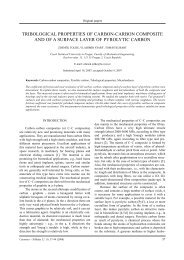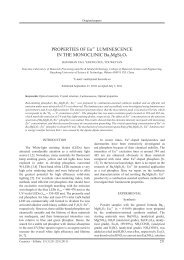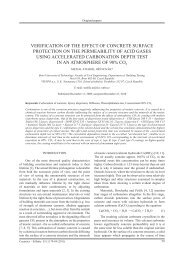Production of calcium sulphate alpha-hemihydrate - Ceramics-Silikaty
Production of calcium sulphate alpha-hemihydrate - Ceramics-Silikaty
Production of calcium sulphate alpha-hemihydrate - Ceramics-Silikaty
You also want an ePaper? Increase the reach of your titles
YUMPU automatically turns print PDFs into web optimized ePapers that Google loves.
INTRODUCTION<br />
Calcium–<strong>sulphate</strong> <strong>alpha</strong>–<strong>hemihydrate</strong> (α–CaSO 4⋅<br />
⋅0.5 H 2O) can be produced by heating natural or<br />
synthetic <strong>calcium</strong>–<strong>sulphate</strong> dihydrate (CaSO 4⋅2 H 2O) in<br />
an autoclave to temperature over 100 °C (autoclave<br />
method). This method has been used only at the<br />
industrial level. The first industries for the autoclave<br />
production <strong>of</strong> <strong>alpha</strong>–<strong>hemihydrate</strong> by this method were<br />
built in Germany (Guilini) in 1962 and Japan (Nitto) in<br />
1973 [1 – 4].<br />
An alternative, the hydrothermal method, <strong>of</strong><br />
<strong>alpha</strong>–<strong>hemihydrate</strong> production is proposed. It consists<br />
<strong>of</strong> dihydrate boiling, or nearly boiling, in aqueous<br />
solutions <strong>of</strong> concentrated salts (with or without<br />
surface–active substance) or inorganic acids, under<br />
atmospheric pressure. This is the latest developed<br />
method for <strong>alpha</strong>–<strong>hemihydrate</strong> production, described<br />
only in literature, which has not yet found the industrial<br />
application. The published information also states that<br />
the method is particularly suitable for waste gypsum<br />
beneficiations, because its impurities can dissolve and<br />
remain in the liquid phase [1, 5, 10, 11, 12]. The<br />
efficient and uniform heat transfer from liquid<br />
(solution) to solid (gypsum) phase and the operation<br />
under atmospheric pressure are the reasons why this<br />
method is employed to economically produce<br />
<strong>hemihydrate</strong> <strong>of</strong> good and uniform quality.<br />
The mechanism <strong>of</strong> <strong>calcium</strong> <strong>sulphate</strong> <strong>alpha</strong><strong>hemihydrate</strong><br />
formation from gypsum by this method has<br />
not yet been well studied and verified. Some<br />
information suggests that the reaction evolves in the<br />
solid phase. Water molecules slowly diffuse in drops<br />
from dihydrate interlayers (solids-state mechanism <strong>of</strong><br />
Original papers<br />
PRODUCTION OF CALCIUM SULPHATE ALPHA-HEMIHYDRATE<br />
FROM CITROGYPSUM<br />
IN UNHEATED SULPHURIC ACID SOLUTION<br />
ALEKSANDRA KOSTIĆ-PULEK, SLOBODANKA MARINKOVIĆ,<br />
VESNA LOGAR, RUDOLF TOMANEC, SVETLANA POPOV<br />
Faculty <strong>of</strong> Mining and Geology, University <strong>of</strong> Belgrad,<br />
Djućina 7, 11000 Belgrade, Yugoslavia<br />
E-mail: ankam@ rgf.org.yu tomanec@rgf.rgf.bg.ac.yu<br />
Submitted July 7, 1999; accepted November 13, 1999.<br />
Alpha-<strong>hemihydrate</strong> <strong>of</strong> <strong>calcium</strong> <strong>sulphate</strong> can be obtained by suspending gypsum in boiling or almost boiling aqueous solution<br />
<strong>of</strong> an inorganic acid salts or sulphuric acid at atmospheric pressure. Our task was to try to obtain it from citrogypsum in<br />
unheated solution <strong>of</strong> this acid. The experiment proved it possible if 10, 15, 20, 30, or 40 wt.% solution was used, and that the<br />
resulting <strong>alpha</strong>-<strong>hemihydrate</strong> developed at various ratios and had different properties, depending on the acid solution<br />
concentration and the gypsum/acid solution mixing ratio. An <strong>alpha</strong>-<strong>hemihydrate</strong> composed <strong>of</strong> smooth, compact, acicular<br />
monocrystals, which according to reference data promises the best utilitarian aspect, was obtained using 20 wt.% acid<br />
solution at 0.25 g cm -3 mixing ratio.<br />
the reaction). Others state that the reaction evolves in<br />
the solution, i.e. it is proceeded by dihydrate passing<br />
into the solution, where from <strong>alpha</strong>-<strong>hemihydrate</strong> separates<br />
by crystallization (through-solution mechanism <strong>of</strong><br />
the reaction). There is also the opinion that the reaction<br />
simultaneously operates in both phases [2 - 5].<br />
The <strong>alpha</strong>-<strong>hemihydrate</strong> grade rises with the<br />
compactness, smoothness and granulation <strong>of</strong> its crystals<br />
on which depends the water requirement controlling<br />
mechanical properties <strong>of</strong> the prepared dihydrate. A<br />
<strong>hemihydrate</strong> composed <strong>of</strong> smooth, compact, large<br />
monocrystals, as described in references, will give a<br />
dihydrate <strong>of</strong> good utilitarian properties.<br />
In view <strong>of</strong> the fact that gypsum is a by−product in<br />
production processes <strong>of</strong> many organic and inorganic<br />
acids, nitrocellulose, pigments, metals and <strong>of</strong> gas<br />
desulphurisation processes (fossil fuel burning products<br />
in industrial plants - so called flue-gas gypsum) and that<br />
it is now, and most likely in the future as well, a<br />
significant ecological problem, the development and<br />
improvement <strong>of</strong> this method for industrial use has full<br />
economic justification [1, 9, 11-19].<br />
In our experiment, an attempt is made to provoke<br />
the dehydration reaction <strong>of</strong> citrogypsum, a by–product<br />
<strong>of</strong> citric acid production, using unheated sulphuric acid<br />
solution in different concentrations (under atmospheric<br />
pressure), and thus obtain the <strong>alpha</strong>–<strong>hemihydrate</strong><br />
product.<br />
The reasons for selecting sulphuric acid solution as<br />
the liquid medium were the following: a) this acid can<br />
be simultaneously obtained in the flue gas desulphurization<br />
unit (on gas washing with water) with flue gas<br />
gypsum which is commonly obtained by gas washing<br />
with lime–water suspension; b) this acid is also a<br />
104 <strong>Ceramics</strong> − Silikáty 44 (3) 104-108 (2000)
<strong>Production</strong> <strong>of</strong> <strong>calcium</strong> <strong>sulphate</strong> <strong>alpha</strong>-<strong>hemihydrate</strong> from citrogypsum in unheated sulphuric acid solution<br />
Table 1. Classical chemical analysis <strong>of</strong> unwashed citro gypsum.<br />
component ignition loss SiO 2 Al 2O 3 Fe 2O 3 CaO MgO SO 3<br />
(wt.%) 2.7 0.83 0.15 0.24 39.28 0.50 55.88<br />
by–product in the production <strong>of</strong> nitrocellulose (here<br />
waste gypsum is produced with acid neutralization by<br />
lime) and some other products, or is in common use in<br />
many processes giving waste gypsum.<br />
It follows from the above stated that the<br />
development <strong>of</strong> the method, which includes the use <strong>of</strong><br />
sulphuric acid solution in gypsum processing, has an<br />
economic justification because the cost <strong>of</strong> sulphuric<br />
acid does not (or in many circumstances does not<br />
significantly) incur a higher cost <strong>of</strong> the product.<br />
Published information indicated that waste gypsum<br />
dehydration reaction occurs in 10, 15, 20, 40 wt.%<br />
solutions <strong>of</strong> sulphuric acid at temperatures higher than<br />
90 o C (at atmospheric pressure) (1, 10). What happens<br />
at lower temperatures? Is it possible to develop the same<br />
reaction, without heating the liquid medium, within a<br />
reasonably long time for industrial usage? Answers to<br />
these questions were sought in the reported<br />
experimental study.<br />
EXPERIMENTAL PART<br />
Citrogypsum was subjected to the classical<br />
chemical, qualitative IR (Perkin Elmer 597), and microscopic<br />
(American Optical-Stereoscopic Microscope)<br />
analyses.<br />
The experiment was performed in laboratory<br />
charge reactor with perfect mixing (n = 600 rpm)<br />
following the procedure: different quantities <strong>of</strong> citrogypsum<br />
(2, 5, 10, 20, 30, 40 grams) were suspended in<br />
the equal volume (40 cm 3 ) <strong>of</strong> sulphuric acid solutions <strong>of</strong><br />
different concentrations (2.5; 5; 10; 15; 20; 30;<br />
40 wt.%) and stirred for a predetermined period.<br />
The product was separated from the liquid phase<br />
by vacuum filtration, rinsed in water, dried at 105 o C,<br />
and examined in qualitative IR, microscopic and DT<br />
analyses (type AMINCO). The contact time <strong>of</strong> phases,<br />
solution and citrogypsum, was prolonged until the<br />
formation <strong>of</strong> <strong>hemihydrate</strong>. In cases <strong>of</strong> the <strong>hemihydrate</strong><br />
non-formation or the product being a mixture <strong>of</strong><br />
<strong>hemihydrate</strong> and dihydrate, the phase-contact time was<br />
prolonged to three hours.<br />
RESULTS AND DISCUSSION<br />
The results <strong>of</strong> classical chemical (table 1) and<br />
qualitative IR (figure 1) analyses indicate pure citrogypsum<br />
substance which can be directly used in <strong>alpha</strong><strong>hemihydrate</strong><br />
production without any pretreatment.<br />
The microscopic analysis <strong>of</strong> citrogypsum showed<br />
its composition <strong>of</strong> thin-tabular, clear and transparent,<br />
colourless crystal aggregates without lustre (typomorphic<br />
<strong>of</strong> gypsum) within a very narrow size range <strong>of</strong><br />
Figure 1. IR spectrum <strong>of</strong> citrogypsum.<br />
0.2 mm average diameter. This implies its direct<br />
usability without any preliminary adjustment <strong>of</strong> size<br />
(grinding) or uniformity (sieving).<br />
The composition <strong>of</strong> the product and the time <strong>of</strong> its<br />
formation were established in a periodical (5 min)<br />
qualitative IR analysis. The formation <strong>of</strong> <strong>hemihydrate</strong><br />
was observed from the appearance <strong>of</strong> an IR spectral<br />
band at 3600 cm -1 , characteristic <strong>of</strong> <strong>hemihydrate</strong>, and<br />
Figure 2. The influence <strong>of</strong> acid solution concentration on product<br />
composition (gypsum/acid solution mixing ratio 0.05 g cm -3 ).<br />
<strong>Ceramics</strong> − Silikáty 44 (3) 104-108 (2000) 105
the disappearance <strong>of</strong> the band at 1680 cm -1 typical <strong>of</strong><br />
dihydrate figures 2 and 3 [6].<br />
Alpha-modification <strong>of</strong> the <strong>hemihydrate</strong> was<br />
verified in microscopic and DT analyses [7].<br />
The experimental results, presented in figures 2<br />
and 3 and tables 2 and 3, show that acid solution<br />
concentration and gypsum/acid solution mixing ratio<br />
A. Kostić-Pulek, S. Marinković, V. Logar, R. Tomanec, S. Popov<br />
Table 2. The influence <strong>of</strong> acid concentration and gypsum/acid solution mixing ratio on product composition and time <strong>of</strong><br />
<strong>hemihydrate</strong> formation.<br />
No acid concentration gypsum/acid solution reaction product time <strong>of</strong> <strong>hemihydrate</strong><br />
solution (wt.%) mixing ratio (g cm -3 ) formation (min)<br />
1 0.050 DH+HH<br />
2 0.125 DH<br />
3 2.5 0.250 DH<br />
4 0.500 DH<br />
5 0.750 DH<br />
6 1.000 DH<br />
7 0.050 HH+DH<br />
8 0.125 DH+HH<br />
9 5.0 0.250 DH<br />
10 0.500 DH<br />
11 0.750 DH<br />
12 1.000 DH<br />
13 0.050 HH 40<br />
14 0.125 HH+DH<br />
15 10.0 0.250 DH+HH<br />
16 0.500 DH<br />
17 0.750 DH<br />
18 1.000 DH<br />
19 0.050 HH 30<br />
20 0.125 DH+HH<br />
21 15.0 0.250 DH<br />
22 0.500 DH<br />
23 0.750 DH<br />
24 1.000 DH<br />
25 0.050 HH 20<br />
26 0.125 HH 16<br />
27 20.0 0.250 HH 10<br />
28 0.500 DH+HH<br />
29 0.750 DH+HH<br />
30 1.000 DH<br />
31 0.050 HH 15<br />
32 0.125 HH+DH<br />
33 30.0 0.250 DH+HH<br />
34 0.500 DH<br />
35 0.750 DH<br />
36 1.000 DH<br />
37 0.050 HH 10<br />
38 0.125 HH+DH<br />
39 40.0 0.250 HH+DH<br />
40 0.500 DH<br />
41 0.750 DH<br />
42 1.000 DH<br />
DH-dihydrate<br />
HH-<strong>hemihydrate</strong><br />
have some effect on the product composition, time <strong>of</strong><br />
<strong>hemihydrate</strong> formation, and its characteristics.<br />
The <strong>calcium</strong> <strong>sulphate</strong> <strong>alpha</strong>-<strong>hemihydrate</strong> was<br />
formed when 10, 15, 20, 30, or 40 wt.% acid solution<br />
was used at the lowest gypsum/acid solution mixing<br />
ratio (experiments 13, 19, 25, 31, 37) and 20 wt.%<br />
H 2SO 4 at the mixing ratio values <strong>of</strong> 0.125 and<br />
106 <strong>Ceramics</strong> − Silikáty 44 (3) 104-108 (2000)
<strong>Production</strong> <strong>of</strong> <strong>calcium</strong> <strong>sulphate</strong> <strong>alpha</strong>-<strong>hemihydrate</strong> from citrogypsum in unheated sulphuric acid solution<br />
Figure 3. The influence <strong>of</strong> gypsum/acid solution mixing ratio<br />
on product composition (20 wt.% H 2SO 4).<br />
0.250 g cm -3 (experiments 26, 27; table 2). In all other<br />
experiments, the obtained products were mixtures <strong>of</strong><br />
dihydrate and <strong>hemihydrate</strong>, with the dihydrate rate<br />
rising with the increasing gypsum/acid solution mixing<br />
ratio or pure dihydrate.<br />
The obtained <strong>alpha</strong>-<strong>hemihydrate</strong> is a mixture <strong>of</strong><br />
two morphologically different phases: a phase <strong>of</strong><br />
smooth, compact, clear, transparent, colourless, acicular<br />
monocrystals and a phase <strong>of</strong> typomorphic aggregates;<br />
with the increasing: a) acid concentration, the rate <strong>of</strong><br />
monocrystal phase decreases and their lengths increase<br />
(experiments 1, 2, 3, 6, 7; table 3); b) gypsum/acid<br />
solution mixing ratio, the rate <strong>of</strong> monocrystals and their<br />
lengths increase and the time <strong>of</strong> their formation<br />
decrease (experiments 3, 4, 5; table 3 and experiments<br />
25, 26, 27; table 2).<br />
How to explain the results, primarily the fact that<br />
the <strong>alpha</strong>-<strong>hemihydrate</strong> was obtained in unheated<br />
solution <strong>of</strong> sulphuric acid? Its formation may probably<br />
be explained by the increased gypsum solubility in<br />
sulphuric acid, caused by the formation <strong>of</strong> a complex<br />
<strong>calcium</strong> compound [8].<br />
CONCLUSIONS<br />
The experimental results lead to the following<br />
statements:<br />
Calcium <strong>sulphate</strong> <strong>alpha</strong>-<strong>hemihydrate</strong> was a product<br />
<strong>of</strong> citrogypsum suspension and stirring in aqueous<br />
solutions <strong>of</strong> sulphuric acid in concentrations <strong>of</strong> 10, 15,<br />
20, 30, 40 wt.% at the gypsum/acid solution mixing<br />
ratio <strong>of</strong> 0.05 g cm -3 at room temperature. In acid<br />
solution <strong>of</strong> 20 wt.%, the <strong>hemihydrate</strong> was obtained also<br />
at the mixing ratio 0.125 or 0.250 g cm -3 .<br />
The time <strong>of</strong> <strong>hemihydrate</strong> formation varied,<br />
decreasing with the increasing acid concentration and<br />
gypsum/acid solution ratio.<br />
The obtained <strong>hemihydrate</strong> consisted <strong>of</strong> two<br />
morphologically different forms: one composed <strong>of</strong><br />
compact, smooth, lustrous regular and clear acicular<br />
monocrystals, and second in tabular aggregates. With<br />
Table 3. The influence <strong>of</strong> acid concentration and gypsum/acid solution mixing ratio on <strong>hemihydrate</strong> crystal morphology and<br />
dimensions.<br />
acid concentration gypsum/acid solution <strong>hemihydrate</strong> crystal morphology and dimensions<br />
(wt.%) mixing ratio (g cm -3 )<br />
10 0.050 Sample made <strong>of</strong> two morphologically different phases: smooth compact<br />
colourless clear transparent acicular monocrystals (average length 16.2 µm),<br />
and typomorphic aggregates 50 µm in average diameter. Phase rate<br />
≈50 wt.%.<br />
15 0.050 Two phases as in exp. 1, only coarser aggregates (55 µm) and longer<br />
monocrystals (20 µm) and more abundant aggregates (≈60 wt.%).<br />
20 0.050 Two phases as in exp. 1, only average crystal length 25 µm and aggregate<br />
diameter 60 µm. Aggregate rate ≈65 wt %.<br />
20 0.125 Same as in exp. 1, only crystals more abundant (≈70 wt.%), average length<br />
28 µm, and aggregates 70 µm average diameter.<br />
20 0.250 Same as in exp. 1, only monocrystal rate ≈95 wt.% (average length 32 µm)<br />
and aggregates 82 µm average diameter.<br />
30 0.050 Same as in exp. 1, only monocrystal rate ≈30 wt.% (average length 28 µm),<br />
and aggregates 62 µm in diameter.<br />
40 0.050 Same as in exp. 1, only monocrystal rate ≈16 wt.% (average length 31 µm),<br />
and aggregates 65 µm average diameter.<br />
<strong>Ceramics</strong> − Silikáty 44 (3) 104-108 (2000) 107
the increasing acid concentration, the ratio <strong>of</strong> monocrystals<br />
decreased and their lengths increased.<br />
In acid solution <strong>of</strong> 20 wt.%, the ratio <strong>of</strong> monocrystals<br />
and their lengths increased with the increasing<br />
gypsum/acid solution mixing ratio; for the ratio <strong>of</strong> 0.25<br />
g cm -3 , the product had 95 wt.% <strong>of</strong> monocrystals,<br />
which, according to reference data, promises the best<br />
utilitarian value <strong>of</strong> dihydrate based on it.<br />
References<br />
1. Zurs A.: J.Amer.Ceram.Soc. 74, 1117 (1991).<br />
2. Combe E., Smith D.: J.Appl.Chem. 18, 307 (1968).<br />
3. Combe E., Smith D.: J.Appl.Chem.Biotechnol. 18, 283<br />
(1971).<br />
4. Singh M., Rai M.: J.Chem.Tech.Biotechnol. 43, 1 (1988).<br />
5. Kostić-Pulek A. et all: Ceramic-<strong>Silikaty</strong> 38, 173 (1994).<br />
6. Niquist R., Hagel R.: Infrared Spectra <strong>of</strong> Inorganic<br />
Compounds, p.231. Academic Press, New York 1971.<br />
7. Powel D.: Nature 20, 375 (1984).<br />
8. Nekrasov B.: Uchebnik obschei khimii, p.495. Moskva<br />
1984.<br />
9. Ulmann A.: Encyclopedia <strong>of</strong> Industrial Chemistry, vol.<br />
A4, p.555.<br />
10. Jarosinski A., at all.: Phosphorous and Potassium No 164,<br />
November–Decembre p.24, 1989.<br />
11. Yamada C. at all.: Gypsum Line, 85, 198 (1966).<br />
12. Fischer K. at all.: Silikattechnik, 15, 361 (1964).<br />
13. Forester J.: Chem. Ing. Tech. 44, 969 (1972).<br />
14. Krueger B.: Process for Producing α–Hemihydrate<br />
Gypsum Crystals from Residue Containing Dihydrate<br />
Gypsum, Ger. Pat. 3522495 A1 (1985).<br />
15. Jarosinski A. at all.: in Monografia 74, Politechnicka<br />
Krakowska, Krakow Vol.81, 97 (1988).<br />
16. Kijakowska R. at all.: Fosfogips Apatitowy–surowiec do<br />
Otrzumuwania Ziem Rzadkich, Wydawnictwo Geol.<br />
Warszawa, 1 (1981).<br />
A. Kostić-Pulek, S. Marinković, V. Logar, R. Tomanec, S. Popov<br />
17. Wirshing F.: Zem–Kalk–Gips 15, 439 (1962).<br />
18. Krueger B.: Process for Conversion <strong>of</strong> Residuum from<br />
Flue Gas Desulfurization to α–Hemihydrate Gypsum<br />
Crystals, Ger. Pat. No 3331838 Al (1983).<br />
19. Krueger B.: Process for Conversion <strong>of</strong> Residuum from<br />
Flue Gas Desulphurization to α–Hemihydrate Gypsum<br />
Crystals from Residua Containing Dihydrate Gypsum,<br />
Ger. Pat., No 3522495 Al (1985).<br />
Submitted in English by the authors.<br />
VÝROBA ALFA HEMIHYDRÁT SÍRANU VÁPENATÉHO<br />
Z ODPADNÍHO SÁDROVCE<br />
V ROZTOKU KYSELINY SÍROVÉ<br />
ALEKSANDRA KOSTIĆ-PULEK, SLOBODANKA MARINKOVIĆ,<br />
VESNA LOGAR, RUDOLF TOMANEC, SVETLANA POPOV<br />
Faculty <strong>of</strong> Mining and Geology, University <strong>of</strong> Belgrade,<br />
Djućina 7, 11000 Belgrade, Yugoslavia<br />
E–mail: ankam@ rgf.org.yu<br />
tomanec@rgf.rgf.bg.ac.yu<br />
Alfa hemihydrát síranu vápenatého může být získán<br />
suspenzováním sádrovce do roztoku solí anorganických kyselin<br />
nebo kyseliny sírové při atmosférickém tlaku a teplotě varu<br />
nebo blízké varu roztoku. Naším cílem bylo pokusit se získat<br />
hemihydrát z odpadního sádrovce při výrobě kyseliny<br />
citrónové. Experiementy potvrdily tuto možnost pokud se<br />
použije 10, 15, 20, 30 nebo 40% roztok. Výsledný produkt měl<br />
odlišné vlastnosti v závislosti na koncentraci kyseliny a poměru<br />
míchání sádrovec - roztok kyseliny. Alfa-hemihydrát složený z<br />
hladkých kompaktních jehlicovitých krystalů, které podle<br />
refernčních dat slibují nejlepší užitkovou hodnotu byla získána<br />
použitím 20 hmotn.% roztoku kyseliny sírové při poměru<br />
míchání 0,25 g sádrovce na 1 ml roztoku.<br />
108 <strong>Ceramics</strong> − Silikáty 44 (3) 104-108 (2000)


